Boas are unquestionably popular snakes among those who like legless pets, and this is due in large part to their diversity. A group comprised of 30-odd species (depending on the authority you consult), boas (the subfamily Boinae) have something to offer everyone.
We’ll dive into a few of the most commonly kept boa species below, so that you can select the pet that’ll best suit your circumstances and desires.
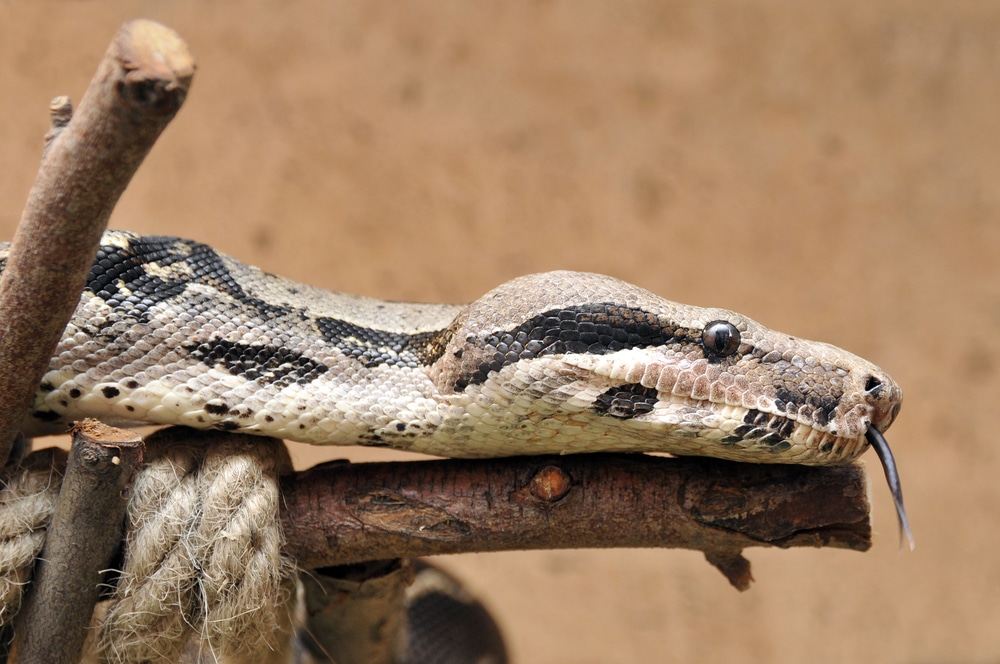
So let’s get into the basics biology of each, as well as the basic care and maintenance requirements – including the difficulty each presents their keeper.
Quick Navigation
Quick Disclaimer: We’re Using “Species” Broadly
We want to familiarize our readers with the types of boas that are commonly available in the pet trade.
Accordingly, we’re not getting bogged down in taxonomic issues surrounding how some species are defined. Some of the animals below are actually different subspecies or geographic variants, rather than different species.
Just know that we mean “types of boas most commonly kept as pets.”
The Seven Boa Constrictor Species Most Commonly Kept as Pets
There aren’t any official statistics regarding which boa species and subspecies are most commonly kept by reptile enthusiasts, but we believe the following seven are likely to be the most popular.
1. Common Boa
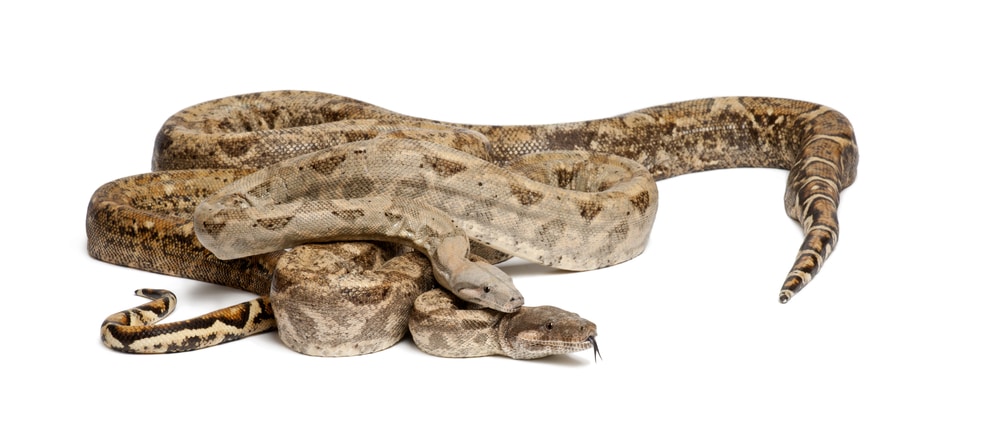
While a few things about boa species popularity may be hard to pin down with certainty, one thing is undeniable: The common boa (Boa constrictor imperator) is the most commonly kept boa among reptile enthusiasts.
Common boas range from Mexico to central South America, and they inhabit a variety of different habitats across this range. Most live in forests of one variety or another, but some are found in residential areas, open swamps, lake margins, or wide-open fields and savannas. Though they are all the same subspecies, they differ relatively significantly in terms of color, pattern and size across this vast range. In fact, some that are found living on islands – such as the Hog Island boa – are colored quite differently than typical members of the group.
Boas have been common among snake-keeping enthusiasts for decades. This is due in part to their close proximity to the United States – African and Indonesian constrictors are simply found farther away and were therefore more difficult to obtain in the past. Nevertheless, even in our modern, interconnected world, common boas remain some of the most popular constrictors in the pet trade. However, the majority of common boas kept in captivity today are born and bred in captivity.
Another reason for the popularity of common boas is their often-docile nature. This varies greatly from one animal to the next, as some are quite defensive and willing to bite if threatened. However, captive bred specimens generally live up to their reputation for being tame, particularly if they are raised from a young age and handled gently and consistently over time.
Boas probably average about 6 or 7 feet in length. But this varies, and these snakes also exhibit sexual dimorphism – females reach much larger sizes than males. Some males will never exceed 4 feet in length, but female specimens may occasionally measure 9 feet in length or more and weigh up to 50. Like all other boas, common boas are livebearers, who often produce large litters after lengthy gestation periods.
Common boas are relatively easy to maintain, and captive-bred individuals usually eat readily. However, given their large size, we’d hesitate to characterize them as “beginner” snakes.
2. Red-Tailed Boa
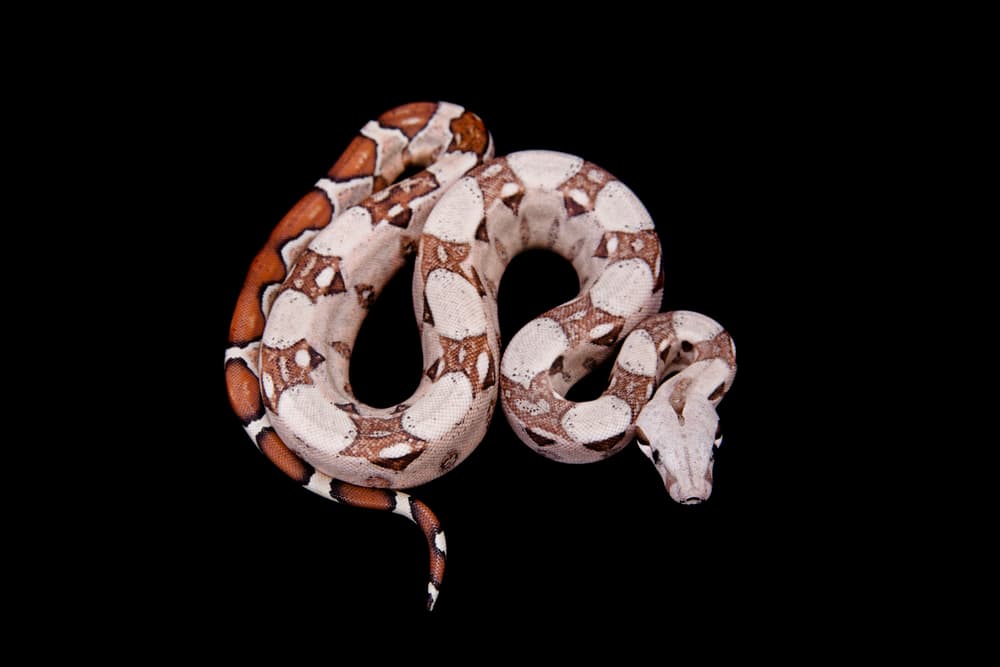
The term red-tailed boa is often mistakenly applied to common boas, but true red-tailed boas are actually a different subspecies: Boa constrictor constrictor.
Red-tailed boas are quite similar to common boas in many ways, but many reptile enthusiasts strongly prefer the former to the latter. Red-tailed boas tend to possess sharper markings and brighter coloration (particularly around the tail), and some grow larger than common boas too.
Red-tailed boas aren’t quite as common in captivity as common boas, but they’re readily available for hobbyists seeking them out. True red-tailed boas typically cost a bit more than their common cousins, but this varies a bit based on the location from which the red-tailed boa hails (they differ quite a bit across their range).
Red-tailed boas are bred in captivity with some regularity, but a significant percentage of those in the pet trade are still wild-caught, imported animals. This, combined with the fact that red-tailed boas are a bit more challenging to maintain and typically more nervous than common boas, makes them better suited for keepers with a bit of experience. Additionally, while many individuals are quite tame, red-tailed boas are generally not as docile as common boas.
3. Rosy Boa
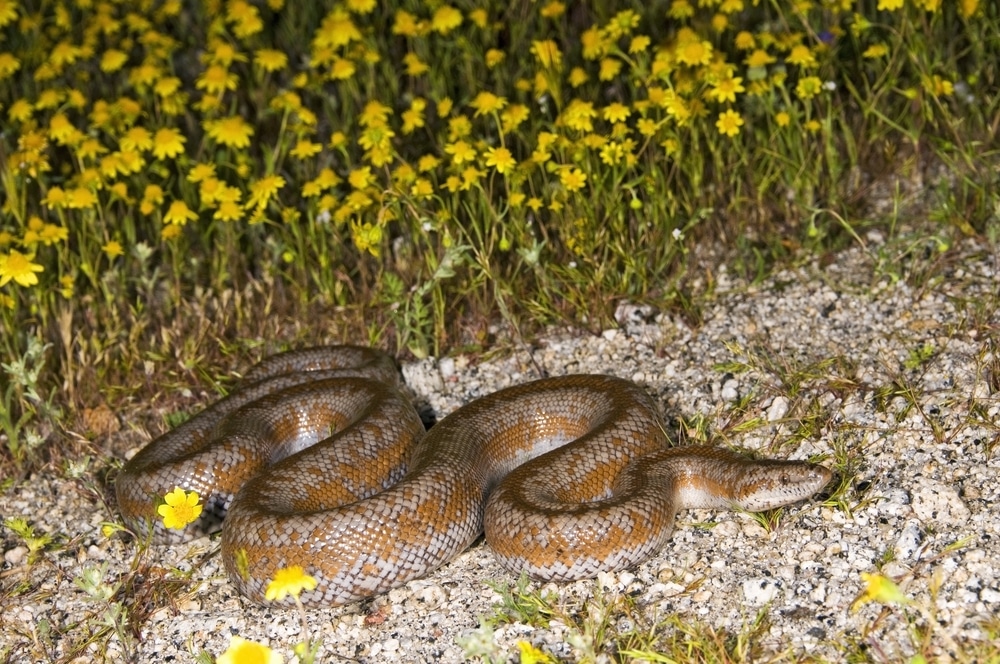
Unlike common and red-tailed boas, rosy boas (Charina trivirgata) are quite small – most measure less than 3 feet in length. Also unlike their larger cousins, rosy boas bear very different color patterns: Whereas common and red-tailed boas are largely brown or grey with perpendicularly oriented markings, rosy boas occur in several different colors (including orange or peach), and they possess longitudinal stripes – a rare trait among boas and other large constrictors.
Although temperaments vary from individual to individual, most rosy boas are pretty docile animals, who’re disinclined to bite. When you combine these gentle dispositions with the species’ small size, rosy boas end up being pretty good pets for beginning snake keepers.
Rosy boas are also relatively easy to keep. Most can be housed in only a few square feet of space, and they have pretty easy-to-satisfy needs in captivity. This not only makes them pretty easy to house, but it also means that keepers can set up relatively elaborate, well-decorated enclosures if they like.
Rosy boas, unlike common and red-tailed boas, hail from the American southwest. This means that they typically thrive best in relatively low-humidity habitats, unlike their tropical and sub-tropical cousins, who require their keepers to maintain high humidity levels. It also means problems like respiratory infections and poor sheds are less common in rosy boas.
Rosy boas are bred in large numbers, so keepers will have no trouble finding captive-bred specimens. Most are relatively affordable too. These factors all combine to make them an excellent boa for beginners – arguably, the very best option of the group.
4. Kenyan Sand Boa
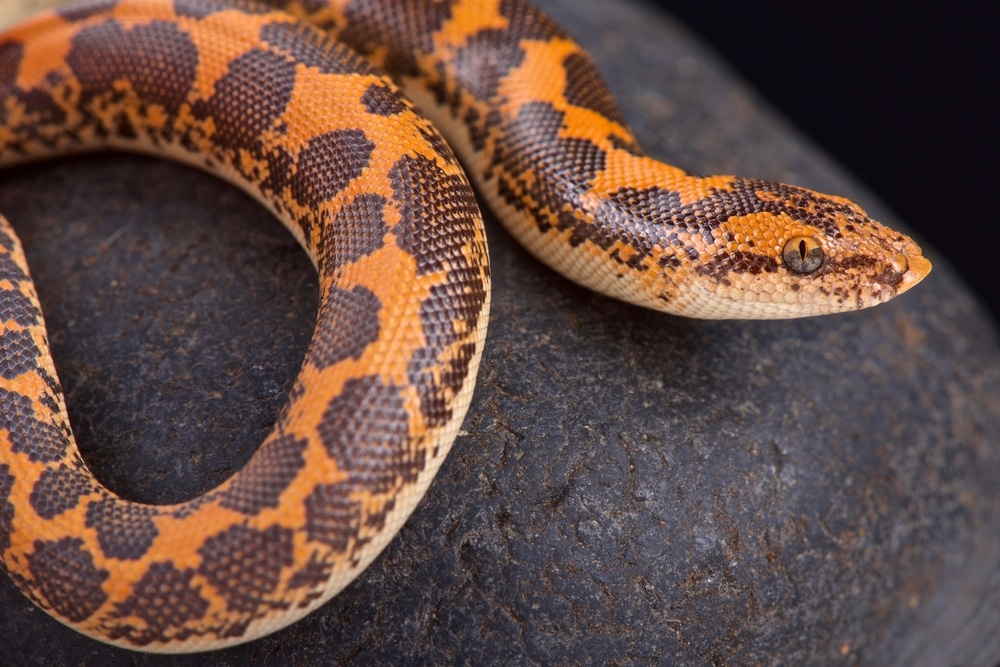
If the rosy boa is the best boa for beginners to keep, the Kenyan sand boa (Gongylophis colubrinus) is certainly the runner up (and some would argue we should swap those species). Indeed, the Kenyan sand boa is a great option for boa-keeping novices. As a species, it is normally quite tame, remarkably hardy, and very undemanding. Give a Kenyan sand boa a warm, sandy, and secure enclosure, and he’ll thrive.
The primary reason we rate the Kenyan sand boa slightly behind the rosy boa in terms of beginner suitability is a bit unusual. If we’re going to be honest, sand boas can be a bit boring to keep. They spend almost all of their time buried under the substrate, and they don’t even move around very much when handled (though they’re typically quite docile). This will cause some fledgling keepers to lose interest, thereby causing them to neglect their pet. But if their lifestyle and characteristic personality aren’t an issue, then they’re a great choice for beginners.
There are a number of sand boa species and subspecies, and all inhabit some portion of a range stretching from central Africa to central Asia. However, the Kenyan sand boa is the most common, readily available, and easy-to-keep species available.
The largest Kenyan sand boa females likely reach or exceed 3 feet in length, but the vast majority are smaller. Males, in particular, rarely exceed 2 feet or so. Captive bred sand boa neonates are very inexpensive, though there are some color mutations available, which fetch higher prices.
5. Amazon Tree Boa
Amazon tree boas (Corallus hortulana) are very common, arboreal boas from Central America. They occur in several different color forms, including a few that are quite attractive, and they have a very distinctive body shape. They’re very long, quite slender, and they possess giant, bulky heads.
Amazon tree boas are often considered the “poor man’s emerald tree boa,” but that does a disservice to these animals, who differ in many ways from their green cousins. For example, while emerald tree boas often laze about for hours in a characteristic draped-over-a-branch coil, Amazon tree boas are more active and generally prefer resting in the crooks of tree branches. For that matter, these snakes will readily descend to the ground at times – a trait that often frustrates keepers who want a constantly arboreal animal.
Amazon tree boas often make rewarding pets, and they’re actually a bit underappreciated in our opinion. For that matter, they’re quite affordable (especially attractive specimens aside), and they’re rarely difficult to find in the pet trade. Wild-caught individuals certainly outnumber captive-bred specimens, but you can find both varieties with ease.
However, they are not a great choice for beginners. These snakes are often very defensive, bordering on pugnacious, which many novices will find off-putting. Some individuals can also be difficult to feed. And while amazon tree boas are not difficult for experienced keepers to maintain, they will likely be quite challenging for most beginners.
6. Emerald Tree Boa
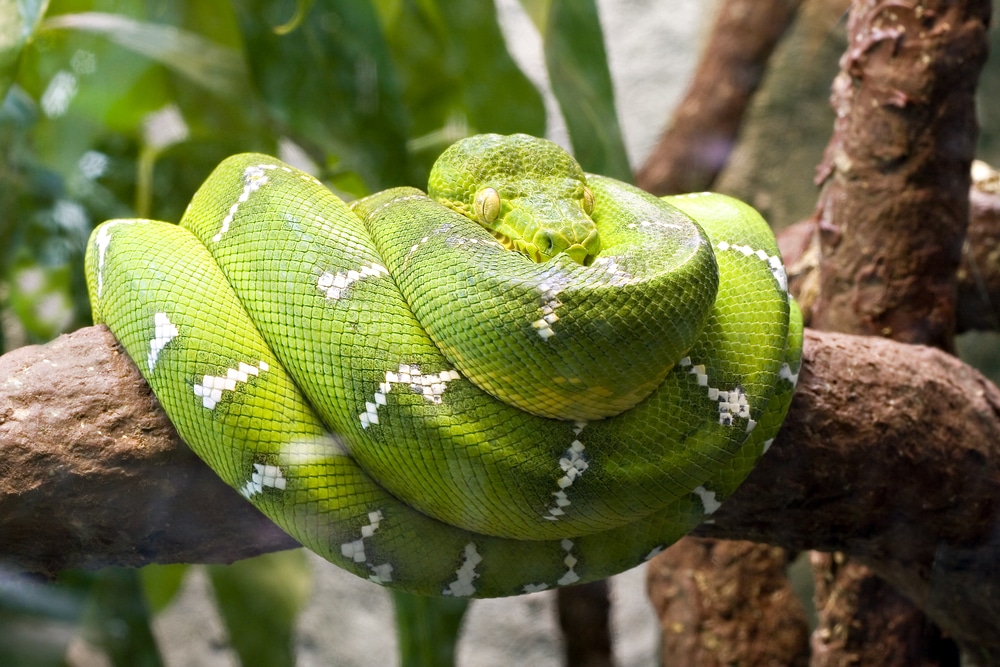
One of the most famous boas in the world, the emerald tree boa is instantly recognizable – as long as you can distinguish the species from the similar-but-very-distantly-related green tree python (Morelia viridis). These two very distant cousins exhibit a phenomenon known as convergent evolution, which means that their evolutionary paths have “converged” on a similar lifestyle and set of physical characteristics.
Emerald tree boas are the only boas clad almost entirely in green scales, and they typically spend the vast majority of their time wrapped around horizontal tree branches. They aren’t as commonly kept as some of the other species listed here, but that’s primarily a reflection of their expensive price tags and the skill required to maintain them successfully. Nevertheless, every boa enthusiast who’s ever drawn breath is familiar with this fascinating species.
There are technically two species of emerald tree boa: the emerald tree boa (Corallus canninus) and the Amazon basin emerald tree boa (Corallus batesii). Both are quite similar, but individuals in the former group are a bit smaller, lighter in color and defensive than the latter. Not coincidentally, they’re also more affordable than their cousins who hail from the Amazon Basin.
Both species require broadly similar care regimens. They need spacious enclosures with plenty of climbing opportunities, warm temperatures and high humidity levels. They are typically not easy to handle, and many individuals will readily bite if disturbed. They are definitely not a good choice for beginners, and even advanced keepers often have difficulty maintaining these species. Nevertheless, they are quite popular in the pet trade and many keepers try to work with them at one point in time or another.
7. Brazilian Rainbow Boa
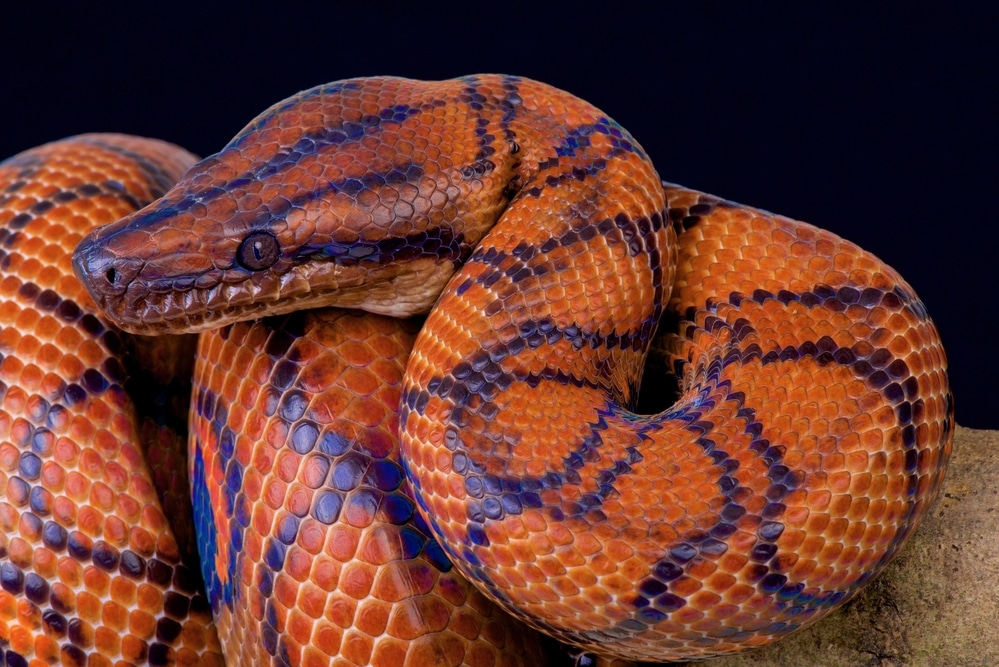
There are several different species and subspecies of the rainbow boas (Epicrates cenchria sspp.), and they’re all quite attractive. Most have very interesting and visually appealing patterns, and the entire group bears very shiny, iridescent scales. However, the Brazilian subspecies (Epicrates cenchria cenchria) is on an entirely different level, which makes it tower above its relatives in terms of popularity.
Clad in a red or orange ground color with dark blue to black markings along the back and sides, these snakes are show-stoppers and always draw plenty of attention at reptile expos and swap meets. Like most other rainbow boas, they reach a manageable size of about 6 feet (though some may grow slightly larger), and they’ll survive on food no larger than a big rat – no need to feed these snakes rabbits or chickens as you may have to do with a large common boa.
Rainbow boas are generally not quite as tame as some of the calmest common, sand or rosy boas, but they’re usually easy to handle. Over time, most captive-bred individuals eventually learn to accept regular, gentle handling. They are somewhat challenging to maintain, as they require very high humidity levels in their enclosures, which makes it more difficult to keep the enclosure clean.
We’d recommend true beginners to look elsewhere, but keepers who’ve already kept a snake or two in the past can likely succeed with this species. Assuming they’re willing to dedicate the proper time and effort to caring for a slightly challenging species.
Conclusion
As you can see, there is certainly no shortage of boa species available to hobbyists. And while the seven species mentioned above are undoubtedly some of the most commonly kept species, many others are readily available. Viper boas (Candoia aspera), Cuban boas (Chilabothrus angulifer), and Columbian rainbow boas (Epicrates maurus) occasionally turn up at pet expos and retail shops. For that matter and though we’ve excluded them here, yellow (Eunectes notaeus) and green anacondas (Eunectes murinus) are arguably boas, as they fit right into the subfamily Boinae. Both species are quite commonly kept and readily available.
Just be sure that you research the needs of any boa species you intend to keep, so you will be able to give your new pet the best quality of life possible. This is beneficial for you, the animal and then entire snake-keeping hobby as a whole.